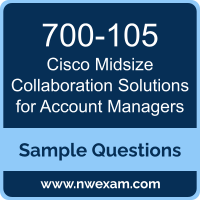01. Cisco Midsize Collaboration Solutions are particularly effective because they address which of the following challenges?
(Choose Two)
a) Need for scalable communication tools
b) Demand for high-cost on-premise solutions
c) Integration with existing technologies
d) Provision of real-time analytics
02. Which deployment scenario is typical for Cisco Midsize Collaboration Solutions in a rapidly expanding company?
a) High-complexity deployment requiring extensive IT support
b) Single-server deployment with limited user access
c) Deployment with minimal customization and fixed modules
d) Scalable deployment that grows with company size
03. Considering the competitive landscape, what does Cisco Business Edition 6000 offer that is often considered a competitive advantage?
a) Lower technological capabilities compared to competitors
b) Integration of cloud services and on-premise solutions
c) Focus on individual rather than collaborative solutions
d) Sole reliance on legacy communication tools
04. How do Cisco's collaboration solutions support mobile workforces in midsize companies?
a) By providing mobile-only solutions
b) Through seamless integration with third-party apps
c) By offering robust mobile collaboration features
d) By limiting access to desktop interfaces
05. Examine the opportunities in the midsize market segment for collaboration technologies. What does the integration of these technologies facilitate?
(Choose Two)
a) Centralized management of resources
b) Enhanced face-to-face interactions
c) Streamlined communication processes
d) Reduced dependency on digital tools
06. In the context of licensing, what advantage does Cisco offer to midsize businesses through its Collaboration Solutions?
a) Fixed licensing fees regardless of the number of users
b) Flexible licensing that adapts to business size and needs
c) Lifetime licenses with no need for renewals
d) Mandatory multi-year contracts
07. What aspect of Cisco Midsize Collaboration Solutions directly addresses the customer's evolving business needs?
a) Flexible scaling options as business grows
b) Limited integration with existing systems
c) High dependency on external IT support
d) Static technological offerings
08. When examining the competitive landscape, what feature makes Cisco Business Edition 6000 stand out?
a) Its reliance on third-party integrations
b) High upfront costs for implementation
c) The comprehensive integration of collaboration tools
d) Limited scalability options
09. How does the combination of Cisco Spark and Cisco Business Edition 6000 deliver value to customers?
a) By minimizing the range of communication tools available.
b) Through a comprehensive suite of collaboration tools that enhance productivity.
c) By increasing the complexity of the communication system.
d) Through reduced security measures to speed up communications.
10. In what way does Cisco differentiate its collaboration solutions with AI capabilities for midsize businesses?
a) Automated administrative tasks
b) Enhanced cybersecurity measures
c) Predictive analytics for user behavior
d) Personalized user experiences
 Before you write the Cisco Midsize Collaboration Solutions for Account Managers (700-105) certification exam, you may have certain doubts in your mind regarding the pattern of the test, the types of questions asked in it, the difficulty level of the questions and time required to complete the questions. These Cisco Midsize Collaboration Solutions for Account Managers (MCAM) sample questions and demo exam help you in removing these doubts and prepare you to take the test.
Before you write the Cisco Midsize Collaboration Solutions for Account Managers (700-105) certification exam, you may have certain doubts in your mind regarding the pattern of the test, the types of questions asked in it, the difficulty level of the questions and time required to complete the questions. These Cisco Midsize Collaboration Solutions for Account Managers (MCAM) sample questions and demo exam help you in removing these doubts and prepare you to take the test.